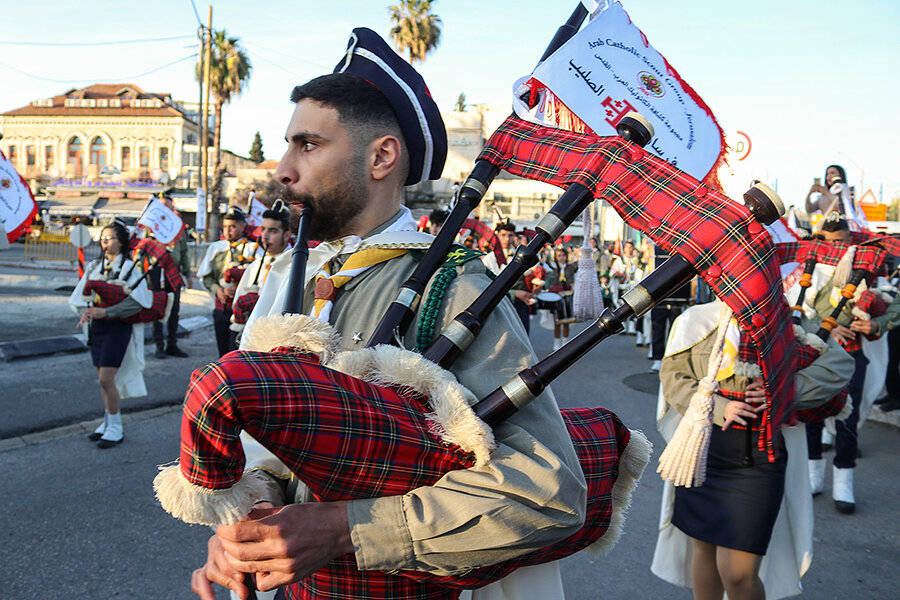Letter from Jerusalem: In a holy week, city parades its better self
| Jerusalem
With Easter, Passover, and Ramadan coinciding this year, the region’s eyes are on Jerusalem, where the slightest provocation can spark deadly violence and a geopolitical uproar.
Which is why I crossed the Jordan River to report from and pray in what may be the most tense religious sites on Earth.
When I first arrived in Jerusalem on March 29 – one week into Ramadan, a week before Passover, and four days prior to Holy Week – followers of the three Abrahamic faiths were visibly wary. Why wouldn’t they be?
Why We Wrote This
A story focused onEaster, Passover, and Ramadan are coinciding amid a season of Israeli-Palestinian tensions. Yet the joy and harmony on display in Jerusalem’s streets creates the feeling that this is the city’s defining character.
The last few months have seen far-right Israeli ministers use their government posts as bully pulpits, a rise in violence and revenge attacks killing Palestinians and Israelis, a wave of vandalism against Christian sites, and a struggle over Israel’s judiciary and democracy straining the Israeli state and society.
In anticipation of this spiritual season, representatives of the U.S., Jordan, Israel, the Palestinian Authority, and Egypt met for multiple days to ensure that Christian, Muslim, and Jewish worshippers have safe and open access to celebrations in Jerusalem this month and to prevent any isolated incident from escalating.
Checkpoints
Yet even a privileged American visitor got a taste of the tensions.
The three-minute walk from my Old City hotel to Al Aqsa Mosque to pray ran through three checkpoints.
At two Israeli police checkpoints I had to produce my passport and an 11-year-old stamped paper from Jordan’s Islamic Court to explain to skeptical young Israeli police that yes, I am a Muslim, and no, I am neither a tourist nor an Israeli.
I had to repeat the procedures at the gate of Al Aqsa itself to the Jerusalem Waqf guards – some of whom I now know on a first-name basis – who initially suspected me of being a tourist or a settler trying to sneak in to light a match that could engulf Jerusalem and the wider area in sectarian flames. Everyone was on alert, with no room for mistakes.
Even inside Al Aqsa, fellow worshippers asked me: “What is your business here?” Leaving Al Aqsa, a group of yeshiva students spotted my Islamic prayer rug and hassled and heckled me all the way to the hotel.
Yet as the days went on, tensions gave way to celebrations.
One outpouring of joy was Palm Sunday, when processions from Bethpage on the Mount of Olives down to the Church of Saint Anne united thousands waving palms and singing songs in a dozen different languages.
But what really caught my eye, and my ear, were the 10 Jerusalem and Palestinian Christian scout groups.
Chanting, and rocking
Decked out in uniforms, many, like George, were born in the West Bank after Israel’s construction of the separation wall and were visiting Jerusalem for the very first time.
After the St. Anne services, these scouts began their annual march around the Old City, filling the air with the sounds of snare drums, bass drums, and bagpipes. Before, the city was chanting hymns. Now, Jerusalem was rocking.
As the scouts marched past Damascus Gate, with sunset less than an hour away, hijab-covered women carrying bags of groceries suddenly forgot their family’s iftar break-fasting meal and stopped to take pictures and clap along.
Israeli Jews, some of whom had started with the procession from the Mt. of Olives hours earlier, stood shoulder-to-shoulder with Palestinian Christians to cheer on the drum majors twirling and throwing their batons like acrobats. Even Israeli police took selfies.
At the end of the procession, as the Armenian scout troop marched from the New Gate into the Armenian Quarter, Orthodox Jews on their way to the Western Wall were swept up in the march, and smiled and bobbed their heads to the music.
After I waved to the last of the marchers filing into the Armenian Monastery, I reversed direction and joined hundreds of Muslim Jerusalemites heading to Al Aqsa, prayer-carpets slung over their shoulders, for tarawih night prayers, their own night of festivities just beginning.
After night prayers under the open sky, young Jerusalemites from the Old City came up and poured me coffee and handed me sweets, a welcome offering to visiting worshippers.
I then followed the thousands exiting Al Aqsa Mosque, up al-Wad Street to Damascus Gate, where food stands, lights, candy of all colors and shapes, music, clowns, and horse rides awaited families and night owls rejuvenated by their sunset meal. There I spotted Palestinian Christian families I recognized from Palm Sunday celebrations buying sweets, and George, still in his scout uniform, eating a pastry and looking wide-eyed at the Ramadan lights.
I smiled and asked him how he was enjoying the festive atmosphere. He grinned.
“This is Jerusalem,” he said.
No matter what happens in the days, weeks, and months ahead, this is what will stay with me. No statement or act – and the days did not pass without the city witnessing isolated, yet contained, violent confrontations, with one fatality – can erase the truth of those three words.
The harmony I witnessed did not feel like an exception to the rule, a rare unity among bickering faiths and denominations, but rather the defining character of Jerusalem, the Holy City’s natural state of grace. The city, much like the diverse religions that worship here, did not belong to extremists, no matter how loud, organized, violent, or well-funded.
This harmony may be short-lived. Before this month is over, an extremist may succeed in defiling a shrine or attacking worshippers, and incite the response they desire. An overreaction may lead to a police killing. In their pursuit of power, cynics and politicians will continue to try to hijack the divine.
But when given a brief respite from political divisions and security restrictions, Jerusalem’s inclusiveness doesn’t just shine – it sings.









